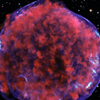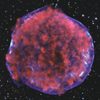CXC Home | Search | Help | Image Use Policy | Latest Images | Privacy | Accessibility | Glossary | Q&A
A Tour of Tycho
Quicktime MPEG
Over four hundred years ago, the Danish astronomer Tycho Brahe studied the explosion of a star that later became known as Tycho's supernova. A look at Tycho in X-rays by NASA's Chandra X-ray Observatory shows that the supernova remnant contains an expanding bubble of superheated debris, which sits within an even more rapidly moving shell of extremely high-energy electrons. A very long Chandra observation of Tycho totaling about a million seconds of time, has uncovered new and unexpected structures in this aftermath of the star's explosion. A series of stripes in the remnant provides novel evidence for particles that have been accelerated to extremely high energies. This is an important clue to better understanding the object that Tycho Brahe first saw back in 1572.
[Runtime: 00:51]
Quicktime MPEG
Over four hundred years ago, the Danish astronomer Tycho Brahe studied the explosion of a star that later became known as Tycho's supernova. A look at Tycho in X-rays by NASA's Chandra X-ray Observatory shows that the supernova remnant contains an expanding bubble of superheated debris, which sits within an even more rapidly moving shell of extremely high-energy electrons. A very long Chandra observation of Tycho totaling about a million seconds of time, has uncovered new and unexpected structures in this aftermath of the star's explosion. A series of stripes in the remnant provides novel evidence for particles that have been accelerated to extremely high energies. This is an important clue to better understanding the object that Tycho Brahe first saw back in 1572.
[Runtime: 00:51]
(Credit: X-ray: NASA/CXC/Rutgers/K.Eriksen et al.; Optical: DSS)
Multiwavelength Views of Tycho's Supernova Remnant
Quicktime MPEG
A long Chandra observation of Tycho has revealed a pattern of X-ray "stripes" never seen before in a supernova remnant. The stripes are seen in the high-energy X-rays (blue) that also show the blast wave, a shell of extremely energetic electrons. Low-energy X-rays (red) show expanding debris from the supernova explosion. The stripes, seen to the lower right of this composite image that includes optical data from the Digitized Sky Survey, may provide the first direct evidence that a cosmic event can accelerate particles to energies a hundred times higher than achieved by the most powerful particle accelerator on Earth.
[Runtime: 00:10]
Quicktime MPEG
A long Chandra observation of Tycho has revealed a pattern of X-ray "stripes" never seen before in a supernova remnant. The stripes are seen in the high-energy X-rays (blue) that also show the blast wave, a shell of extremely energetic electrons. Low-energy X-rays (red) show expanding debris from the supernova explosion. The stripes, seen to the lower right of this composite image that includes optical data from the Digitized Sky Survey, may provide the first direct evidence that a cosmic event can accelerate particles to energies a hundred times higher than achieved by the most powerful particle accelerator on Earth.
[Runtime: 00:10]
(Credit: X-ray: NASA/CXC/Rutgers/K.Eriksen et al.; Optical: DSS)
Return to Tycho's Supernova Remnant Animations (March 24, 2011)




